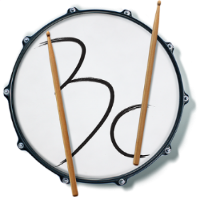Expanding Your Vocabulary: The Power of Permutations
If you’ve been taking drum lessons, you probably played patterns like double strokes and single paradiddles thousands of times. Perhaps you even feel yourself getting trapped cycling through the same few ideas over and over. Need a way to dig out of a creative rut while vastly expanding your drumming vocabulary? Try playing different permutations of patterns you already know.
What are Permutations?
A permutation is when you begin a pattern from a different position than usual. For example, if you had double strokes played as RRLL RRLL, you could reposition the pattern so it begins from the second right hand stroke. Then, the pattern becomes RLLR RLLR. They’re still double strokes, but they’ve been offset by one note.
One of the main purposes of learning different rudiments is to achieve different inflections. Playing different permutations of patterns results in unique inflections not otherwise accessible by playing a pattern in its original position. And this process can apply to literally any pattern you can think of. However, it’s very easy to become overwhelmed by possibilities. It’s best to start with rudiments and patterns you’re already familiar with before branching out into more intricate combinations. To get off the ground, we’ll cover permutations of double strokes and single paradiddles, and explore a couple ways to apply permutations to the drum set.
Double Strokes
Going back to the double strokes mentioned above (RRLL RRLL), we can begin the pattern from any other stroke. Since the pattern contains 4 strokes, there are 3 other permutations in addition to the pattern’s original position. We can continuously shift the pattern forward by one stroke to work through each permutation. The original position is RRLL RRLL, the first permutation (shifting everything ahead by one stroke, otherwise known as inverted doubles) is RLLR RLLR, the second permutation is LLRR LLRR (doubles leading with the left hand), and the final permutation is LRRL LRRL.
Practice each permutation individually before playing through them all as a sequence. Josh plays through each permutation in the below video. To make it easier to hear how the pattern shifts against the underlying beat, he plays with his right hand on the floor tom and left hand on the snare drum. The hihats mark each beat.
Double strokes (or any sticking pattern) can also be split between between the hands and feet. In the next demonstration, the kick takes the place of the right hand. The right hand will just play quarter notes on the hihats to mark time while the left hand and kick play through the double stroke permutations. Coordination becomes a bit more of an obstacle with this approach.
Single Paradiddles
We can apply the same method to single paradiddles (RLRR LRLL), too, which have more motion to them compared to double strokes. Since single paradiddles alternate the leading hand (switching from right lead to left lead each beat), we’ll only explore permutations where the right hand begins on beat 1.
The original position is RLRR LRLL. The first permutation, otherwise known as inverted paradiddles, entails shifting the double strokes to the middle of each beat so the pattern becomes RLLR LRRL. The second permutation begins with the double strokes, RRLR LLRL. And the final permutation has the double strokes straddle the beats, RLRL LRLR. Like during the demonstration of double strokes, Josh plays with his right hand on the floor tom and left hand on the snare to make it easier to hear how to pattern shifts against the beat.
It’s also a good idea to split these patterns between the kick and left hand while keeping time with the right hand on the hihats. Simply play the kick in place of the right hand. These combinations are a great way to improve coordination and control, and could even lay the foundation to some interesting grooves.
Rhythmic Positions
Another good way to apply permutations is by cycling a rhythm through different positions of a beat. As an example, let’s say you’re playing 16th notes using both hands on the hihats and you want to improve coordinating the bass drum with the hands. You could start by playing the kick directly on each beat, then shift the kick back by a 16th note to the ‘e’ of each beat, then shift it back again to the ‘&’ of each beat, and then finally shift it back to the ‘a’ of each beat. Cycling through these kick positions allows you to practice all the possible ways of playing single-16th kicks in a beat.
To take things a step further, let’s say the kick rhythm is 2 consecutive 16th notes. We can then permute this rhythmic cell through all the different 16th note positions. Start by playing the kick on the first 2 16th notes of each beat (1 e, 2 e, 3 e, 4 e), then shift the rhythm back by a 16th so it plays on the ‘e’ and ‘&’ of each beat, then bump it back again so it plays on the ‘&’ and ‘a’ of each beat, and then finally the last position where the kick plays the first and last 16th notes of each beat. Since the hands are constantly alternating, the bass drum will switch between aligning with each hand. That’s a tricky thing to coordinate at first!
Beyond these exercises, try exploring permutations of other rudiments, sticking patterns, and rhythms. Working through this process will vastly expand your vocabulary, phrasing abilities, and overall control. Begin combining permutations of various patterns to encounter all sorts of wild combinations you likely wouldn’t have otherwise discovered!







